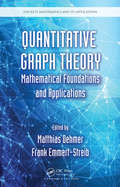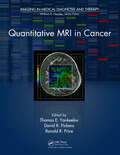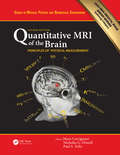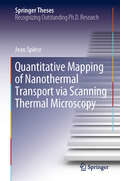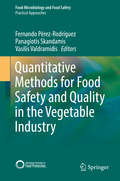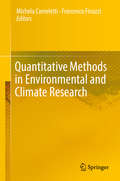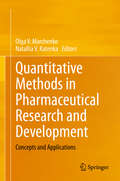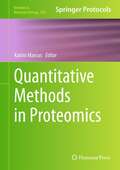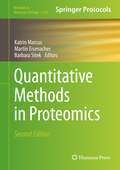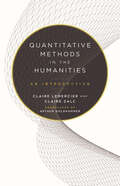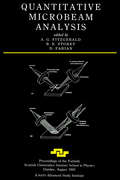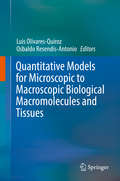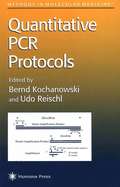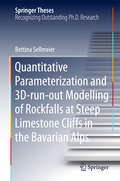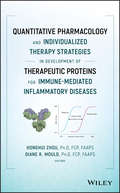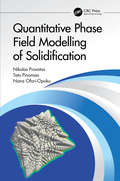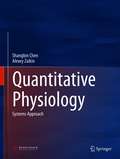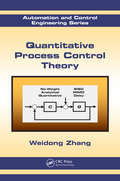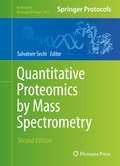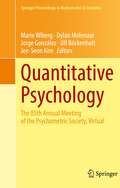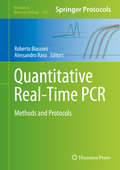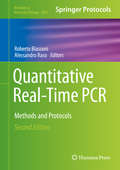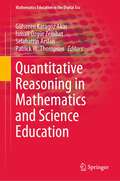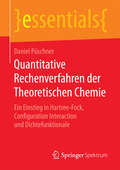- Table View
- List View
Quantitative Graph Theory: Mathematical Foundations and Applications
by Matthias Dehmer Frank Emmert-StreibThe first book devoted exclusively to quantitative graph theory, Quantitative Graph Theory: Mathematical Foundations and Applications presents and demonstrates existing and novel methods for analyzing graphs quantitatively. Incorporating interdisciplinary knowledge from graph theory, information theory, measurement theory, and statistical technique
Quantitative MRI in Cancer (Imaging in Medical Diagnosis and Therapy)
by Thomas E. Yankeelov David R. Pickens Ronald R. PricePropelling quantitative MRI techniques from bench to bedside, Quantitative MRI in Cancer presents a range of quantitative MRI methods for assessing tumor biology. It includes biophysical and theoretical explanations of the most relevant MRI techniques as well as examples of these techniques in cancer applications.The introductory part of the book c
Quantitative MRI of the Brain: Principles of Physical Measurement, Second edition (Series in Medical Physics and Biomedical Engineering)
by Mara Cercignani Nicholas G. Dowell Paul S. ToftsBuilding on the success of the first edition of this book, the winner of the 2004 British Medical Association Radiology Medical Book Competition, Quantitative MRI of the Brain: Principles of Physical Measurement gives a unique view on how to use an MRI machine in a new way. Used as a scientific instrument it can make measurements of a myriad of physical and biological quantities in the human brain and body. For each small tissue voxel, non-invasive information monitors how tissue changes with disease and responds to treatment. The book opens with a detailed exposition of the principles of good practice in quantification, including fundamental concepts, quality assurance, MR data collection and analysis and improved study statistical power through minimised instrumental variation. There follow chapters on 14 specific groups of quantities: proton density, T1, T2, T2*, diffusion, advanced diffusion, magnetisation transfer, CEST, 1H and multi-nuclear spectroscopy, DCE-MRI, quantitative fMRI, arterial spin-labelling and image analysis, and finally a chapter on the future of quantification. The physical principles behind each quantity are stated, followed by its biological significance. Practical techniques for measurement are given, along with pitfalls and examples of clinical applications. This second edition of this indispensable 'how to' manual of quantitative MR shows the MRI physicist and research clinician how to implement these techniques on an MRI scanner to understand more about the biological processes in the patient and physiological changes in healthy controls. Although focussed on the brain, most techniques are applicable to characterising tissue in the whole body. This book is essential reading for anyone who wants to use the gamut of modern quantitative MRI methods to measure the effects of disease, its progression, and its response to treatment. Features: The first edition was awarded the book prize for Radiology by the British Medical Association in 2004 Written by an authority in the field: Professor Tofts has an international reputation for quantification in MRI Gives specific ‘how to’ information for implementation of MRI measurement sequence techniques
Quantitative Mapping of Nanothermal Transport via Scanning Thermal Microscopy (Springer Theses)
by Jean SpièceThe thesis tackles one of the most difficult problems of modern nanoscale science and technology - exploring what governs thermal phenomena at the nanoscale, how to measure the temperatures in devices just a few atoms across, and how to manage heat transport on these length scales. Nanoscale heat generated in microprocessor components of only a few tens of nanometres across cannot be effectively fed away, thus stalling the famous Moore's law of increasing computer speed, valid now for more than a decade. In this thesis, Jean Spièce develops a novel comprehensive experimental and analytical framework for high precision measurement of heat flows at the nanoscale using advanced scanning thermal microscopy (SThM) operating in ambient and vacuum environment, and reports the world’s first operation of cryogenic SThM. He applies the methodology described in the thesis to novel carbon-nanotube-based effective heat conductors, uncovers new phenomena of thermal transport in two- dimensional (2D) materials such as graphene and boron nitride, thereby discovering an entirely new paradigm of thermoelectric cooling and energy production using geometrical modification of 2D materials.
Quantitative Methods for Food Safety and Quality in the Vegetable Industry
by Fernando Pérez-Rodríguez Panagiotis Skandamis Vasilis ValdramidisThis book focuses on the food safety challenges in the vegetable industry from primary production to consumption. It describes existing and innovative quantitative methods that could be applied to the vegetable industry for food safety and quality, and suggests ways in which such methods can be applied for risk assessment. Examples of application of food safety objectives and other risk metrics for microbial risk management in the vegetable industry are presented. The work also introduces readers to new preservation and packaging methods, advanced oxidative processes (AOPs) for disinfection, product shelf-life determination methods, and rapid analytic methods for quality assessment based on chemometrics applications, thus providing a quantitative basis for the most important aspects concerning safety and quality in the vegetable sector.
Quantitative Methods in Environmental and Climate Research
by Michela Cameletti Francesco FinazziThis books presents some of the most recent and advanced statistical methods used to analyse environmental and climate data, and addresses the spatial and spatio-temporal dimensions of the phenomena studied, the multivariate complexity of the data, and the necessity of considering uncertainty sources and propagation. The topics covered include: detecting disease clusters, analysing harvest data, change point detection in ground-level ozone concentration, modelling atmospheric aerosol profiles, predicting wind speed, precipitation prediction and analysing spatial cylindrical data. <P><P>The volume presents revised versions of selected contributions submitted at the joint TIES-GRASPA 2017 Conference on Climate and Environment, which was held at the University of Bergamo, Italy. As it is chiefly intended for researchers working at the forefront of statistical research in environmental applications, readers should be familiar with the basic methods for analysing spatial and spatio-temporal data.
Quantitative Methods in Pharmaceutical Research and Development: Concepts and Applications
by Olga V. Marchenko Natallia V. KatenkaThis contributed volume presents an overview of concepts, methods, and applications used in several quantitative areas of drug research, development, and marketing. Chapters bring together the theories and applications of various disciplines, allowing readers to learn more about quantitative fields, and to better recognize the differences between them. Because it provides a thorough overview, this will serve as a self-contained resource for readers interested in the pharmaceutical industry, and the quantitative methods that serve as its foundation. Specific disciplines covered include:BiostatisticsPharmacometricsGenomicsBioinformaticsPharmacoepidemiologyCommercial analyticsOperational analyticsQuantitative Methods in Pharmaceutical Research and Development is ideal for undergraduate students interested in learning about real-world applications of quantitative methods, and the potential career options open to them. It will also be of interest to experts working in these areas.
Quantitative Methods in Proteomics
by Katrin MarcusProtein modifications and changes made to them, as well as the quantities of expressed proteins, can define the various functional stages of the cell. Accordingly, perturbations can lead to various diseases and disorders. As a result, it has become paramount to be able to detect and monitor post-translational modifications and to measure the abundance of proteins within the cell with extreme sensitivity. While protein identification is an almost routine requirement nowadays, reliable techniques for quantifying unmodified proteins (including those that escape detection under standard conditions, such as protein isoforms and membrane proteins) is not routine. Quantitative Methods in Proteomics gives a detailed survey of topics and methods on the principles underlying modern protein analysis, from statistical issues when planning proteomics experiments, to gel-based and mass spectrometry-based applications. The quantification of post-translational modifications is also addressed, followed by the "hot" topics of software and data analysis, as well as various overview chapters which provide a comprehensive overview of existing methods in quantitative proteomics. Written in the successful Methods in Molecular BiologyTM series format, chapters include introductions to their respective topics, lists of the necessary materials and reagents, step-by-step, readily reproducible protocols, and notes on troubleshooting and avoiding known pitfalls. Authoritative and easily accessible, Quantitative Methods in Proteomics serves as a comprehensive and competent overview of the important and still growing field of quantitative proteomics.
Quantitative Methods in Proteomics (Methods in Molecular Biology #2228)
by Martin Eisenacher Katrin Marcus Barbara SitekThis second edition provides new and updated methods on the principles underlying modern protein analysis, from statistical issues to gel-based and mass spectrometry-based applications. Chapters detail protein quantification as basis for realisation of quantitative studies, gel-based and mass spectrometry-based quantification techniques, TMT, IPTL, PRM, MALDI Imaging, SILAC, PTM analysis, DIA, cross-linking, and the up-to-date topics of software and data analysis. Written in the highly successful Methods in Molecular Biology series format, chapters include introductions to their respective topics, lists of the necessary materials and reagents, step-by-step, readily reproducible laboratory protocols, and tips on troubleshooting and avoiding known pitfalls. Authoritative and cutting-edge, Quantitative Methods in Proteomics, Second Edition aims to provide comprehensive and competent overview in the important and still growing field of quantitative proteomics.
Quantitative Methods in the Humanities: An Introduction
by Claire Zalc Claire LemercierThis timely and lucid guide is intended for students and scholars working on all historical periods and topics in the humanities and social sciences--especially for those who do not think of themselves as experts in quantification, "big data," or "digital humanities."The authors reveal quantification to be a powerful and versatile tool, applicable to a myriad of materials from the past. Their book, accessible to complete beginners, offers detailed advice and practical tips on how to build a dataset from historical sources and how to categorize it according to specific research questions. Drawing on examples from works in social, political, economic, and cultural history, the book guides readers through a wide range of methods, including sampling, cross-tabulations, statistical tests, regression, factor analysis, network analysis, sequence analysis, event history analysis, geographical information systems, text analysis, and visualization. The requirements, advantages, and pitfalls of these techniques are presented in layperson’s terms, avoiding mathematical terminology.Conceived primarily for historians, the book will prove invaluable to other humanists, as well as to social scientists looking for a nontechnical introduction to quantitative methods. Covering the most recent techniques, in addition to others not often enough discussed, the book will also have much to offer to the most seasoned practitioners of quantification.
Quantitative Microbeam Analysis (Scottish Graduate Ser. #40)
by A G Fitzgerald B E Storey D Fabian P OsborneQuantitative Microbeam Analysis provides a comprehensive introduction to the field of quantitative microbeam analysis (MQA). MQA is a technique used to analyze subatomic quantities of materials blasted from a surface by a laser or particle beam, providing information on the structure and composition of the material. Contributed to by international experts, the book is unique in the breadth of microbeam analytical techniques covered. For each technique, it develops the theoretical background, discusses practical details relating to choice of equipment, and describes the current advances. The book highlights developments relating to Auger electron spectroscopy in scanning electron microscopes and transmission electron microscopes and advances in surface analytical imaging and accelerated ion beam-surface interactions.
Quantitative Models for Microscopic to Macroscopic Biological Macromolecules and Tissues
by Luis Olivares-Quiroz Osbaldo Resendis-AntonioThis book presents cutting-edge research on the use of physical and mathematical formalisms to model and quantitatively analyze biological phenomena ranging from microscopic to macroscopic systems. The systems discussed in this compilation cover protein folding pathways, gene regulation in prostate cancer, quorum sensing in bacteria to mathematical and physical descriptions to analyze anomalous diffusion in patchy environments and the physical mechanisms that drive active motion in large sets of particles, both fundamental descriptions that can be applied to different phenomena in biology. All chapters are written by well-known experts on their respective research fields with a vast amount of scientific discussion and references in order the interested reader can pursue a further reading. Given these features, we consider Quantitative Models for Microscopic to Macroscopic Biological Macromolecules and Tissues as an excellent and up-to-date resource and reference for advanced undergraduate students, graduate students and junior researchers interested in the latest developments at the intersection of physics, mathematics, molecular biology, and computational sciences. Such research field, without hesitation, is one of the most interesting, challenging and active of this century and the next.
Quantitative Models in Life Science Business: From Value Creation to Business Processes (SpringerBriefs in Economics)
by Jung Kyu Canci Philipp Mekler Gang MuThis open access book explores the field of life science business from a multidisciplinary perspective. Applying statistical, mathematical, game-theoretic, and data science tools to pharmaceutical and biotechnology business endeavors, the book describes value creation, value maintenance, and value realization in the life sciences as a sequence of processes using the quantitative language of applied mathematics. Written by experts from a variety of fields, the contributions illustrate the shift from a deterministic to a stochastic view of the processes involved, offering a new perspective on life sciences economics. The book covers topics such as valuing and managing intellectual property in life science, licensing in the pharmaceutical business, outsourcing pharmaceutical R&D, and stochastic modelling of a pharmaceutical supply chain. The book will appeal to scholars of economics and the life sciences, as well as to professionals in chemical and pharmaceutical industries.
Quantitative PCR Protocols
by Bernd Kochanowski Udo ReischlThis is a significant collection of established and novel methods for the successful quantitation of nucleic acids. Each method has been refined and tested by its developer and proven to work in such problems as the analysis of eukaryotic gene expression, the quantitation of viral loads in clinical specimens, reporter gene expression, and quantitative oncogene analysis. Particular emphasis is placed on the underlying principles of the design of competitive or noncompetitive standards, as well as on the optimization of the amplification process. In important cases several methods are given for the same problem so that readers may set up test systems tailored to their specific practical needs. With its step-by-step instructions, Quantitative PCR Protocols allows researchers to address biological and diagnostic questions that are difficult or impossible to answer using any other experimental approach.
Quantitative Parameterization and 3D-run-out Modelling of Rockfalls at Steep Limestone Cliffs in the Bavarian Alps
by Bettina SellmeierThis pioneering work deals with the parameterization of rockfalls in the context of 3D run-out modelling at a study site in the Bavarian Alps. The main objective was to cover not only low-magnitude, high-frequency rockfalls (
Quantitative Pharmacology and Individualized Therapy Strategies in Development of Therapeutic Proteins for Immune-Mediated Inflammatory Diseases
by Honghui Zhou Diane R. MouldThorough Overview Identifies and Addresses Critical Gaps in the Treatment of Several Chronic Diseases With increasing numbers of patients suffering from Immune-Mediated Inflammatory Diseases (IMIDs), and with the increasing reliance on biopharmaceuticals to treat them, it is imperative that researchers and medical practitioners have a thorough understanding of the absorption, distribution, metabolism and excretion (ADME) of therapeutic proteins as well as translational pharmacokinetic/pharmacodynamic (PK/PD) modeling for them. This comprehensive volume answers that need to be addressed. Featuring eighteen chapters from world-renowned experts and opinion leaders in pharmacology, translational medicine and immunology, editors Honghui Zhou and Diane Mould have curated a much-needed collection of research on the advanced applications of pharmacometrics and systems pharmacology to the development of biotherapeutics and individualized treatment strategies for the treatment of IMIDs. Authors discuss the pathophysiology of autoimmune diseases in addition to both theoretical and practical aspects of quantitative pharmacology for therapeutic proteins, current translational medicine research methodologies and novel thinking in treatment paradigm strategies for IMIDs. Other notable features include: • Contributions from well-known authors representing leading academic research centers, specialized contract research organizations and pharmaceutical industries whose pipelines include therapeutic proteins • Chapters on a wide range of topics (e.g., pathophysiology of autoimmune diseases, biomarkers in ulcerative colitis, model-based meta-analysis use in the development of therapeutic proteins) • Case studies of applying quantitative pharmacology approaches to guiding therapeutic protein drug development in IMIDs such as psoriasis, inflammatory bowel disease, multiple sclerosis and lupus Zhou and Mould’s timely contribution to the critical study of biopharmaceuticals is a valuable resource for any academic and industry researcher working in pharmacokinetics, pharmacology, biochemistry, or biotechnology as well as the many clinicians seeking the safest and most effective treatments for patients dealing with chronic immune disorders.
Quantitative Phase Field Modelling of Solidification
by Nikolas Provatas Tatu Pinomaa Nana Ofori-OpokuThis book presents a study of phase field modelling of solidification in metal alloy systems. It is divided in two main themes. The first half discusses several classes of quantitative multi-order parameter phase field models for multi-component alloy solidification. These are derived in grand potential ensemble, thus tracking solidification in alloys through the evolution of the chemical potentials of solute species rather than the more commonly used solute concentrations. The use of matched asymptotic analysis for making phase field models quantitative is also discussed at length, and derived in detail in order to make this somewhat abstract topic accessible to students. The second half of the book studies the application of phase field modelling to rapid solidification where solute trapping and interface undercooling follow highly non-equilibrium conditions. In this limit, matched asymptotic analysis is used to map phase field evolution equations onto the continuous growth model, which is generally accepted as a sharp-interface description of solidification at rapid solidification rates. This book will be of interest to graduate students and researchers in materials science and materials engineering. Key Features Presents a clear path to develop quantitative multi-phase and multi-component phase field models for solidification and other phase transformation kinetics Derives and discusses the quantitative nature of the model formulations through matched interface asymptotic analysis Explores a framework for quantitative treatment of rapid solidification to control solute trapping and solute drag dynamics
Quantitative Physiology: Systems Approach
by Shangbin Chen Alexey ZaikinStephen Hawking says that the 21st century will be the century of complexity and indeed now systems biology or medicine means dealing with complexity. Both the genome and physiome have emerged in studying complex physiological systems. Computational and mathematical modeling has been regarded as an efficient tool to boost the understanding about living systems in normal or pathophysiological states.Covering applied methodology, basic case studies and complex applications, this volume provides researchers with an overview of modeling and computational studies of physiology (i.e. quantitative physiology), which is becoming an increasingly important branch of systems biology.This book aims to build multi-scale models to investigate functions in living systems and explain how biomolecules, cells, organs, organ systems and organisms carry out the chemical or physical functions. Some of the models addressed are related to gene expression, calcium signalling, neural activity, blood dynamics and bone mechanics.Combining theory and practice, with extensive use of MATLAB, this book is designed to establish a paradigm for quantitative physiology by integrating biology, mathematics, physics and informatics etc. To benefit from this book, the readers are expected to have a background in general physiology and mathematics
Quantitative Process Control Theory (ISSN)
by Weidong ZhangQuantitative Process Control Theory explains how to solve industrial system problems using a novel control system design theory. This easy-to-use theory does not require designers to choose a weighting function and enables the controllers to be designed or tuned for quantitative engineering performance indices such as overshoot.In each chapter, a s
Quantitative Proteomics by Mass Spectrometry
by Salvatore SechiThis volume is a compendium of cutting-edge protocols for quantitative proteomics, and presents the most significant methods used in the field today. The focus on mass spectrometry (MS) is integral. Attention is given to state-of-the-art techniques for the characterization of the phosphoproteome and tandem MS for detection of inborn errors of metabolism. This volume is an indispensable resource in the search for novel biomarkers.
Quantitative Psychology: The 85th Annual Meeting of the Psychometric Society, Virtual (Springer Proceedings in Mathematics & Statistics #353)
by Marie Wiberg Jorge González Dylan Molenaar Ulf Böckenholt Jee-Seon KimThis proceedings volume highlights the latest research and developments in psychometrics and statistics. It represents selected and peer-reviewed presentations given at the 85th Annual International Meeting of the Psychometric Society (IMPS), held virtually on July 13-17, 2020. The IMPS is one of the largest international meetings on quantitative measurement in education, psychology and the social sciences. It draws approximately 500 participants from around the world, featuring paper and poster presentations, symposiums, workshops, keynotes, and invited presentations. Leading experts and promising young researchers have written the included chapters. The chapters address a wide variety of topics including but not limited to item response theory, adaptive testing, Bayesian estimation, propensity scores, and cognitive diagnostic models. This volume is the 9th in a series of recent works to cover research presented at the IMPS.
Quantitative Real-Time PCR
by Roberto Biassoni Alessandro RasoQuantitative Real-Time PCR: Methods and Protocols focuses on different applications of qPCR ranging from microbiological detections (both viral and bacterial) to pathological applications. Several chapters deal with quality issues which regard the quality of starting material, the knowledge of the minimal information required to both perform an assay and to set the experimental plan, while the others focus on translational medicine applications that are ordered following an approximate logical order of their medical application. The last part of the book gives you an idea of an emerging digital PCR technique that is a unique qPCR approach for measuring nucleic acid, particularly suited for low level detection and to develop non-invasive diagnosis. Written for the Methods in Molecular Biology series, most chapters include introductions to their respective topics, lists of the necessary materials and reagents, step-by-step, laboratory protocols and tips on troubleshooting and avoiding known pitfalls. Practical and authoritative, Quantitative Real-Time PCR: Methods and Protocols aims to aid researchers seeking to devise new qPCR-based approaches related to his or her area of investigation.
Quantitative Real-Time PCR: Methods and Protocols (Methods in Molecular Biology #2065)
by Roberto Biassoni Alessandro RasoThis book expands upon the useful first edition by exploring classic Quantitative Polymerase Chain Reaction (qPCR) techniques as well as a number of recently developed applications. With the changes in instrumentation due to technological advances and the development of new reagents to fulfill ethical and legal issues, the qPCR field is now an up-to-date technology that indeed is widely used in research and clinical diagnostics. Written for the highly successful Methods in Molecular Biology series, chapters include introductions to their respective topics, lists of the necessary reagents, step-by-step, readily reproducible laboratory protocols, and tips on troubleshooting and avoiding known pitfalls. Revised and authoritative, Quantitative Real-Time PCR: Methods and Protocols, Second Edition is an ideal guide to this expanding and vital field of study.
Quantitative Reasoning in Mathematics and Science Education (Mathematics Education in the Digital Era #21)
by Patrick W. Thompson Gülseren Karagöz Akar İsmail Özgür Zembat Selahattin ArslanThis book focuses on quantitative reasoning as an orienting framework to analyse learning, teaching and curriculum in mathematics and science education. Quantitative reasoning plays a vital role in learning concepts foundational to arithmetic, algebra, calculus, geometry, trigonometry and other ideas in STEM. The book draws upon the importance of quantitative reasoning and its crucial role in education. It particularly delves into quantitative reasoning related to the learning and teaching diverse mathematics and science concepts, conceptual analysis of mathematical and scientific ideas and analysis of school mathematics (K-16) curricula in different contexts. We believe that it can be considered as a reference book to be used by researchers, teacher educators, curriculum developers and pre- and in-service teachers.
Quantitative Rechenverfahren der Theoretischen Chemie: Ein Einstieg in Hartree-Fock, Configuration Interaction und Dichtefunktionale (essentials)
by Daniel PüschnerDaniel Püschner stellt sowohl grundlegende Methoden der Computerchemie als auch heute genutzte moderne Methoden wie Coupled Cluster und die Dichtefunktionaltheorie vor. Mithilfe der Wellenfunktionstheorie wird in diesem essential gezeigt, wie die Energie eines Systems berechnet werden kann. Anschließend geht der Autor auf die Probleme der behandelten Methoden ein und zeigt, wie diese systematisch behoben werden können. Insbesondere in der Forschung ist die Computerchemie heutzutage nicht mehr wegzudenken. Obwohl die meisten Eigenschaften auch experimentell zugänglich sind, können Ergebnisse aus quantenmechanischen Rechnungen dabei helfen, die experimentellen Ergebnisse zu verstehen und zu interpretieren. Ein grundlegendes Verständnis ist daher auch für Experimentalchemiker unerlässlich, weshalb im Rahmen des Chemiestudiums die Grundlagen der Theoretischen Chemie behandelt werden. Für dieses essential werden Grundkenntnisse in den Bereichen der Mathematik und der Theoretischen Chemie ebenfalls vorausgesetzt.
